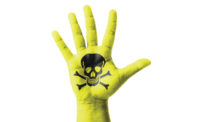In 2012, 58 million Americans sought an attorney.1 The median starting salary for new lawyers in 2012 was $61,000 and many new lawyers carry student-loan debts of $125,000.2 Lawyers are hungry for work. So if your work involves chemical exposures, and particularly if you have acquired the CIH credential, be prepared to eventually provide deposition, testimony, and possibly be cross-examined in legal matters.
Could you answer these common questions in the legal process: Were you aware that some chemical could cause an adverse health effect? What was the exposure concentration of the chemical(s) for the particular claim? How were exposures controlled?
An immersion into the new reality of chemical exposures is necessary to protect health, successfully maneuver through the legal system, and avoid embarrassment that may end or stall a progressing career. Here are some challenges to overcome:
1 REACH-like legislation
In June 2007, EU REACH came into force. European countries believed the legislation was necessary to better understand and better manage the health and environmental impact of chemicals.
The U.S. is ripe for change. The TSCA Modernization Act passed a House vote 389-1 in June 2015. A similar Senate bill has majority support. Arguments presist on how best to regulate existing and new chemical use in the U.S. Regardless of the stall on new federal law (be aware that state law on chemicals continues to grow), toxicological information generated elsewhere in the world reaches the U.S. with Internet ease and speed. You can’t close your mind to new information.
2 New chemicals
New chemicals create new challenges on sample collection and measurement techniques, and professionals are exposed to an ever-expanding number of new chemicals. The legal definition of nanomaterial — there are now thousands of different types — didn’t even exist until 2011, for example.
3 Global OELs
You can’t rely on old information. Most of OSHA’s PELs are based on 1968 TLVs, with some of the TLVs developed decades earlier. You’re naïve if you only rely on PELs and TLVs for health protection and risk assessment. OSHA’s 2012 HazCom encourages use of global OELs.
REACH DNELs generated by chemical manufacturers is an important OEL that must be used if you are leery of the U.S. legal system. And DNELs and similar OELs continue grow stricter. PPM measurements are making way for PPB measurements. And the PPT measurement, the one second in 32,000 years concept, is no longer far-fetched as an OEL.
4 Dose and timing
In June 2007, The Faroes Statement: Human Health Effects of Developmental Exposure to Chemicals in Our Environment called for an update to the centuries-old toxicological principle that “dose makes the poison.” Dose and timing, particularly during early life exposure to chemicals, makes the poison is the new understanding. The Faroes Statement, created by leading researchers across the globe in environmental health, chemistry, toxicology and epidemiology, set off a global chain of events for population exposure perhaps more important than REACH-like legislation.
Expanding upon evidence from Faroes, the Endocrine Society, American College of Occupational and Environmental Medicine, American Academy of Pediatrics, American Medical Association, The American College of Obstetricians and Gynecologists, The American College of Nurse-Midwives, and the American Society for Reproductive Medicine all issued recent statements calling for more attention to early-life exposure to chemicals arising from workplace risks.
On October 1, 2015, nearly all of these organizations, plus the World Health Organization, published a joint “special communication” in the International Journal of Gynecology and Obstetrics and it was also presented at the International Federation of Gynecology and Obstetrics (FIGO) world congress held in Vancouver, BC.3 Recommendations include a call for greater stakeholder involvement, policy changes and strong encouragement that every OBGYN should counsel their patients and inquire about workplace exposure to chemicals.
You may not be familiar with most of these groups, but the public and lawyers are well aware of their work. If you’re involved in toxic tort litigation outside of workers’ compensation law, early-life exposures may arise, and you’re certain to be asked about your awareness of these and similar position statements on chemical exposures.
5 OSHA HazCom
Full compliance with OSHA HazCom is June 1, 2016. Savvy professionals should look carefully at what due diligence actions, as opposed to OSHA non-compliance actions, are created during conformance with HazCom. Consider closely what due diligence obligations are imposed by the HazCom prevention statement, “Obtain special instructions before use,” means for CMR chemical exposures. If litigation arises, lawyers will seek out these special instructions.
6 Can you be aware of everything?
Especially if you carry professional certifications, you’re expected to be aware, at least minimally, of many things. For example, an article that explained the Faroes Statement appeared in an October 2007 issue of ISHN. Many professionals have mobile apps such as the GESTIS Substance Database on their smartphone. GESTIS, a free chemical information product from Germany, but available in English, has thousands of chemical entries. If you work with a chemical, GESTIS awareness for that chemical may be expected.
7 Smart apps, dumb people?
Anyone can put GESTIS and similar apps on their smartphone – but can everyone properly understand and apply the information? Apps may refine searches for chemicals, such as those that may contain allergic ingredients, or may be carcinogenic, mutagenic, or toxic to reproduction e.g. health hazard classifications in OSHA HazCom. Uninformed people may ask smart people, such as credentialed professionals, “My app says chemical X is in the product. What’s my exposure and will the exposure make me sick?”
Bottom line: the proliferation of chemical information and its ease of access can create low-hanging fruit in terms of lawsuits.
References
1. https://en.wikipedia.org/wiki/Attorneys_in_the_United_States
3. http://www.ijgo.org/article/S0020-7292(15)00590-1/fulltext


